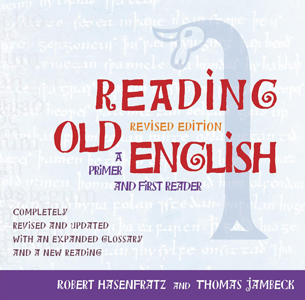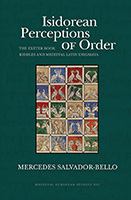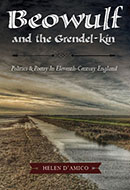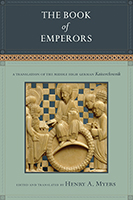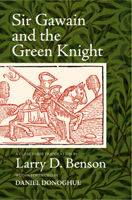Summary
Revised, Updated, and Expanded!
With the immersion method dominating contemporary language learning, the knowledge of traditional grammar is at a low ebb, creating real barriers to any student wanting to learn dead or historical languages. This revised edition of Reading Old English aims to equip readers (advanced undergraduates, graduate students, and autodidacts) with the necessary tools to read the oldest recorded forms of the English language by explaining key language features clearly and methodically, without dumbing down or simplifying any of the core grammatical concepts. It includes a number of helpful exercises, a variety of interesting and unusual Old English texts to translate, as well as appendices covering the basics of traditional grammar and sound changes in Old English, along with an introduction to poetic structure.
Contents
- PREFACE
- HOW TO USE THIS BOOK
- ACKNOWLEDGMENTS
- ABBREVIATIONS
- CHAPTER ONE (Old English Alphabets and Pronunciation)
- Lesson One: Old English Alphabets
- A Crash Course in Anglo-Saxon Paleography
- Lesson Two: Pronunciation
- The Briefest Possible Guide to Pronouncing Old English
- Detailed Description of Old English Pronunciation
- General Guidelines
- Vowels
- Old English/Modern Vowel Equivalents
- International Phonetic Alphabet
- Vowels and Diphthongs
- Consonant Sounds
- Voice
- Classifying Consonants
- Stops
- Fricatives
- Affricates
- Liquids
- Semivowels
- Nasals
- Old English Consonants
- Exercise 1.9.1: Pronouncing OE Vowels
- Exercise 1.9.2: Pronouncing OE Diphthongs
- Exercise 1.9.3: Pronouncing OE Consonants
- Exercise 1.9.4: IPA Exercise
- Exercise 1.9.5: Pronounciation Practice
- Lesson One: Old English Alphabets
- CHAPTER TWO (Getting Started: Nouns)
- Lesson One: Nouns
- Anatomy of a Sentence
- What the Endings Do
- Gender
- Ælfric on the Concept of Gender
- A Few Tips
- The Definite Article (the)
- Indefinitely (The Indefinite Article)
- Pronoun Preview
- Lesson Two: Main Noun Groups
- Ælfric on Nouns
- Regular Masculines
- Regular Feminines
- Regular Neuters
- Short and Long Stems
- Looking Up
- Syncopate!
- Dæġ / Dagas Alternation
- O-Wo-Jo, A-Wa-Ja Stems
- Exercise 2.1: Identifying Short and Long Stems
- Lesson Three: The Concept of Case
- Nominative
- Accusative
- Genitive
- Dative
- Instrumental
- Ælfric on the Concept of Case
- Exercise 2.2: Understanding Case
- Exercise 2.3: Getting the Grammar Right
- Reading II: Practice Sentences
- Vocabulary for Reading
- Lessons Learned
- Lesson One: Nouns
- CHAPTER THREE (“Weak” Nouns and Regular Verbs)
- Lesson One: Weak Nouns
- Spotting Weak Nouns
- Masculine Weak Nouns
- Feminine Weak Nouns
- Neuter Weak Nouns
- Summary of Weak Noun Endings
- Exercise 3.1: Understanding Case and Weak Nouns
- Lesson Two: Weak Verbs
- Ælfric on Verbs
- Principal Parts of OE Weak Verbs
- Verb Categorization
- Classes of Weak Verbs
- Weak Verb Endings (Conjugations)
- Mood
- Indicative
- Imperative
- Subjunctive
- Mood
- Weak Verbs of Class I
- Collapsed Endings
- Another Infinitive
- -ing Forms (Present Participles)
- Sound Changes and Class I Weak Verbs
- Weak Verbs of Class II
- Distinguishing Weak I from Weak II
- Exercise 3.2: Weak Verb Spotting
- Reading III.i: The Gospel of Luke
- Vocabulary for Reading
- Reading III.ii: Exeter Book Riddle #82
- Vocabulary for Reading
- Lessons Learned
- Lesson One: Weak Nouns
- CHAPTER FOUR (Weak Verbs Class III and Irregular Verbs)
- Lesson One: Weak Verbs, Class III
- Weak Verbs Class III: habban, hycgan, libban and secgan
- Timesavers
- Genitive Objects
- Contractions
- Exercise 4.1: Learning Weak III Verbs
- Vocabulary for Exercise
- Exercise 4.2: More Reverse Translation
- Vocabulary for Exercise
- Distinctive Endings
- Lesson Two: Unusual and Irregular Verb Forms
- Preterite (Past)-Present Verbs
- Important Preterite-Present Helping Verbs
- Other Important Preterite-Present Verbs
- Timesavers
- Negatives
- Preterite-Present Verb Conjugation
- Let’s Shall
- Some Irregularities: Anomalous Verbs
- Timesavers
- Time and Being (wesan vs. bēon)
- Negatives
- Anomalous Verbs: dōn, gān
- willan, nyllan
- Timesavers
- I-Mutation
- Implied Motion
- Exercise 4.3: How to Stop Worrying and Live with Preterite-Present and Irregular Verbs
- Exercise 4.4: Translation Exercise
- Vocabulary for Exercise
- Preterite (Past)-Present Verbs
- Reading IV: Wonders of the East (1)
- Vocabulary for Reading
- Lessons Learned
- Lesson One: Weak Verbs, Class III
- CHAPTER FIVE (Learning How to Translate)
- Step 1: Locating Clauses
- Subordination
- Exercise 5.1: Locating Clauses
- Step 2: Finding the Complete Verb
- Verbs with a Complex
- Having and Being
- Timesavers
- Weorðan
- Helpful verbs
- Some Small Exceptions
- Compounding the Problem
- A Practice Run
- Tenses
- Accusative with Infinitive Constructions
- Another Wrinkle
- Exercise 5.2: Translating Accusative with Infinitives
- Vocabulary for Exercise
- Summary
- Exercise 5.3: Finding the Complete Verb
- Step 3: Finding the Subject
- A Practice Run
- Exercise 5.4: Finding the Subject
- Step 4: Sorting Out the Rest
- Find the Direct Objects
- A Practice Run: The Search for Objects
- The Dative Rule
- The Genitive Rule
- Exercise 5.5: Applying the Dative and Genitive Rules
- Vocabulary for Exercise
- A Practice Run
- Pulling it All Together
- Find the Direct Objects
- Exercise 5.6: Sorting Out the Rest
- Vocabulary for Exercises
- Reading V: Wonders of the East (2)
- Latin Original
- Vocabulary for Reading
- Lessons Learned
- Step 1: Locating Clauses
- CHAPTER SIX (Adjectives and Adverbs, Prepositions)
- Lesson One: Adjectives
- Strong Adjectives
- Timesavers
- Adjectives Ending in –u
- Timesavers
- Strong and Weak Adjectives
- Weak Adjectives
- Exercise 6.1: Recognizing “Strong” and “Weak” Adjectives
- Vocabulary for Exercise
- Participles as Adjectives
- Exercise 6.2: Participles as Adjectives
- Vocabulary for Exercise
- Strong Adjectives
- Lesson Two: Comparative and Superlative Forms
-
- Ælfric on Adjectives
- Comparative + Personal Ending
- Superlatives
- “Than” Marker
- Comparative as Intensifier
- Irregular Adjectives with Different Roots
- Exercise 6.3: Recognizing Comparatives and Superlatives
- Vocabulary for Exercise
-
- Lesson Three: Adverbs
- Ælfric on Adverbs
- Irregular Forms
- Comparative and Superlative Forms
- Irregular Forms
- Exercise 6.4: Distinguishing Adverbs from Adjectives
- Vocabulary for Exercise
- Lesson Four: Prepositions
- Exceptional
- Post-Positions
- Either/Or Prepositions
- Instrumental
- Exercise 6.4: Prepositional Phrases
- Vocabulary for Exercise
- A Puzzle
- Reading VI: Wonders of the East (3)
- Latin Original
- Vocabulary for Reading
- Lessons Learned
- Lesson One: Adjectives
- CHAPTER SEVEN (Personal Pronouns, Reflexives, Relatives)
- Lesson One: Personal Pronouns
- First Person
- Second Person
- Third Person
- Agreements and Disagreements
- Ælfric on Pronouns
- Timesavers
- Definite Article as Pronoun
- Reduced Endings
- Exercise 7.1: Personal Pronouns
- Vocabulary for Exercise
- Possessive
- Timesaver
- Datives of Possession
- Timesaver
- Lesson Two: Reflexive Pronouns
- Verbs which Require a Reflexive
- Exercise 7.2: Possessive and Reflexive Pronouns
- Vocabulary for Exercise
- Lesson Three: Who/Which (Relative Pronouns)
- Three Alternatives
- Indeclinable Particle þe
- A Definite Article + þe
- A Definite Article Alone
- Headless Sentences
- Exercise 7.3: Relative Pronouns
- Vocabulary for Exercise
- Why?: Interrogative Pronouns
- This and That: Demonstrative Pronouns
- Miscellaneous Pronouns
- Whatever, Whoever
- Three Alternatives
- Reading VII.i: Prognostics (1)
- Vocabulary for Reading
- Reading VII.ii: Monastic Sign Language
- Vocabulary for Reading
- Lessons Learned
- Lesson One: Personal Pronouns
- CHAPTER EIGHT (Strong Verbs I)
- Lesson One: Definitions
- Strong Verb Classes
- Class 1 Strong Verbs
- Class 2 Strong Verbs
- Class 3 Strong Verbs
- Class 4 Strong Verbs
- Exercise 8.1: Conjugating Strong Verbs
- Lesson Two: Conjugation of Strong Verbs
- bītan and bēodan
- bindan and brecan
- Lesson Three: Summary of Base Forms
- Timesavers
- Syncopation and Assimilation
- Mutating Vowels
- Exercise 8.2: Understanding Class 1-4 Strong Verbs
- Exercise 8.3: Recognizing Syncopation, Assimilation, and I-Mutation
- Exercise 8.4: Translation Practice
- Vocabulary for Exercise
- Timesavers
- Reading VIII.i: Prognostics (2)
- Vocabulary for Reading
- Reading VIII.ii: From Vercelli Homily IX (1)
- Vocabulary for Reading
- Lessons Learned
- Lesson One: Definitions
- CHAPTER NINE (Strong Verbs II)
- Lesson One: Classes 5-7
- Class 5 Strong Verbs
- Class 6 Strong Verbs
- Class 7 Strong Verbs
- Lesson Two: Conjugation of Strong Verbs
- sprecan and standan
- hātan and gangan
- Lesson Three: A Few Exceptions
- Some Irregular Strong Verbs
- biddan, licgan, steppan, and wēpan
- Exercise 9.1: Understanding Class 5, 6, and 7 Strong Verbs
- Exercise 9.2: Infinitives
- Exercise 9.3: Translation Exercise
- Vocabulary for Exercise
- Reading IX: Vercelli Homily IX (2)
- Vocabulary for Reading
- Lessons Learned
- Lesson One: Classes 5-7
- CHAPTER TEN (Rarer Noun Forms)
- -/e/ in the Nominative
- Endings with –w-
- Masculines
- Neuters
- Feminines
- Feminine –jo- Stems
- Foot-Feet (I-Mutation) Nouns
- Mother/Father Nouns
- U-Nouns
- Abstract Feminine Nouns in -þu /-þo
- Children Nouns
- Noun Stems Ending in –þ
- Nouns from Present Participles
- I-stem Nouns
- Masculine, Neuter
- Feminine
- Exercise 10.1: Translation
- Vocabulary for Exercise
- Exercise 10.2: Translation
- Vocabulary for Exercise
- Reading X: Vercelli Homily IX (3)
- Vocabulary for Reading
- Lessons Learned
- CHAPTER ELEVEN (Contract Verbs, Impersonal Constructions)
- Lesson One: Contract Verbs
- Contract Verbs by Class
- Conjugation of Contract Verbs
- þēon and tēon
- sēon and fōn
- Exercise 11.1: Understanding the Forms of Contract Verbs
- Exercise 11.2: Infinitives
- Exercise 11.3: Translating Contract Verbs
- Vocabulary for Exercise
- Lesson Two: Impersonals
- Exercise 11.4: Recognizing Impersonal Constructions
- Vocabulary for Exercise
- Exercise 11.4: Recognizing Impersonal Constructions
- Reading XI: The Human Fetus
- Vocabulary for Reading
- Lessons Learned
- Lesson One: Contract Verbs
- APPENDIX ONE: A Basic Introduction to Traditional Grammar
- APPENDIX TWO: Summary of Sound Changes
- ADDITIONAL READINGS
- The Old English Gloss to Ælfric’s Latin Colloquy
- Four /Lives/ of St. Æðeldryð
- Account of St. Æðeldr ð in Bede’s Ecclesiastical History of the English People
- Account of St. Æðeldr ð in the OE Translation of Bede’s Ecclesiastical History
- The Brief Life of St. Æðeldr ð from the OE Martyrology
- Ælfric’s Life of St. Æðeldr ð
- Æðeldr ð in the News
- A Quick Guide to Old English Poetry
- The Wife’s Lament
- MAIN GLOSSARY
Editors
Robert Hasenfratz and Thomas J. Jambeck are both Professors of Medieval Studies at University of Connecticut.
Reviews
"This is a book that will feed enthusiasm. Throughout the ten chapters in which the basics of Old English grammar are covered, cleverly chosen phrases and sentences of Old English gradually build a secure reading knowledge, leading the readers to translate confidently and idiomatically. Particularly impressive is the authors' willingness to confront readers with Latin."
Jane Roberts, Professor Emerita, King's College London and Senior Research Fellow, Institute of English Studies, University of London
"Other introductory texts seem reluctant to abandon the 'serious' philological and historical background to Old English, a reluctance that can have serious consequences for the subject's appeal to today's students. By focusing on the main goal of learning to translate Old English texts, students gain access to this fascinating body of literature much more quickly. Their confidence is bolstered, and as my experience has shown, many of them go on to learn more about the language and culture once they have mastered the basics. In short, this approach generates enthusiasm and a desire to learn, rather than stifling it."
David F. Johnson, Florida State University







